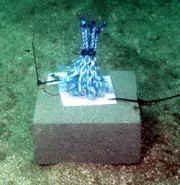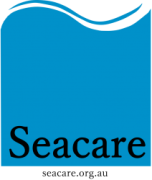Type of resources
Topics
Keywords
Contact for the resource
Provided by
Years
-
The Tasman Fracture CMR AUV survey was a pilot study undertaken in 2014/15 as part of the National Marine Biodiversity Hub's National monitoring, evaluation and reporting theme. The aim of this theme is to develop a bluepint for the sustained monitoring of the South-east Commonwealth Marine Reserve Network. The particular aim of the survey was to contribute to an inventory of the distribution and cover of epibenthic biota in the reserve using IMOS AUV 'Sirius'. Data contained here represents a scored subset of the ~ 18,400 images collected at the Tasman Fracture CMR. Images were scored for proportion cover of visible macrobiota using 25 random points superimposed on each image. Taxon were biologically classified using UTAS morphospecies classification scheme, which can be mapped back to CATAMI (http://catami.org/).
-
Data accompanying Layton et al. 2019, Resilience and stability of kelp forests: the importance of patch dynamics and environment-engineer feedbacks. PLOS ONE. To explore how resilience and stability of kelp habitats is influenced by this habitat degradation, we created an array of patch reefs of various sizes and supporting adult Ecklonia radiata kelp transplanted at different densities. This enabled testing of how sub-canopy abiotic conditions change with reductions in patch size and adult kelp density, and how this influenced demographic processes of microscopic and macroscopic juvenile kelp.
-
Water quality and biological data was collected from four tide-dominated river estuaries indicative of catchments with varying levels of human impacts to: 1) assess draft indicator levels for water quality, and 2) investigate biological indicators of estuarine health in NW Tasmania. The data represented by this record was collected in the Duck Bay.
-
The data is the quantitative abundance of megafaunal invertebrates derived from underwater visual census methods involving transect counts at rocky reef sites around Tasmania. This data forms part of a larger dataset that also surveyed fish abundance and algal cover for the area. The aggregated dataset allows examination of changes in Tasmanian shallow reef floral and faunal communities over a decadal scale - initial surveys were conducted in 1992-1995, and again at the same sites in 2006-2007. There are plans for ongoing surveys. An additional component was added in the latter study - a boat ramp study looking at the proximity of boat ramps and their effects of fishing. We analysed underwater visual census data on fishes and macroinvertebrates (abalone and rock lobsters) at 133 shallow rocky reef sites around Tasmania that ranged from 0.6 - 131 km from the nearest boat ramp. These sites were not all the same as those used for the comparison of 1994 and 2006 reef communities. The subset of 133 sites examined in this component consisted of only those sites that were characterized by the two major algal (kelp) types (laminarian or fucoid dominated). Sites with atypical algal assemblages were omitted from the 196 sites surveyed in 2006. This study aimed to examine reef community data for changes at the community level, changes in species richness and introduced species populations, and changes that may have resulted from ocean warming and fishing. The methods are described in detail in Edgar and Barrett (1997). Primarily the data are derived from transects at 5 m depth and/or 10 m depth at each site surveyed. The underwater visual census (UVC) methodology used to survey rocky reef communities was designed to maximise detection of (i) changes in population numbers and size-structure (ii) cascading ecosystem effects associated with disturbances such as fishing, (iii) long term change and variability in reef assemblages.
-

Community assembly in macrofauna communities developed in artificial kelp holdfasts was monitored at 1-month intervals over a 13 month period using a sampling design that used systematic patterns of temporal overlap and changes in start and collection dates. The hierarchical nature of the experimental design allowed several different approaches to analysis; by date of deployment and by date of collection of the artificial habitats, which enabled comparison of community assembly with and without the seasonal effects of the date of collection, and by community age to test whether there were alternative end-states to assembly depending on season or recruitment history.
-
-- Layton et al. Chemical microenvironments within macroalgal assemblages: implications for the inhibition of kelp recruitment by turf algae. Limnology & Oceanography. DOI:10.1002/lno.11138 -- Kelp forests around the world are under increasing pressure from anthropogenic stressors. A widespread consequence is that in many places, complex and highly productive kelp habitats have been replaced by structurally simple and less productive turf algae habitats. Turf algae habitats resist re-establishment of kelp via recruitment inhibition; however little is known about the specific mechanisms involved. One potential factor is the chemical environment within the turf algae and into which kelp propagules settle and develop. Using laboratory trials, we illustrate that the chemical microenvironment (O2 concentration and pH) 0.0–50 mm above the benthos within four multispecies macroalgal assemblages (including a turf-sediment assemblage and an Ecklonia radiata kelp-dominated assemblage) are characterised by elevated O2 and pH relative to the surrounding seawater. Notably however, O2 and pH were significantly higher within turf-sediment assemblages than in kelp-dominated assemblages, and at levels that have previously been demonstrated to impair the photosynthetic or physiological capacity of kelp propagules. Field observations of the experimental assemblages confirmed that recruitment of kelp was significantly lower into treatments with dense turf algae than in the kelp-dominated assemblages. We demonstrate differences between the chemical microenvironments of kelp and turf algae assemblages that correlate with differences in kelp recruitment, highlighting how degradation of kelp habitats might result in the persistence of turf algae habitats and the localised absence of kelp.
-
The spatial extent of C. rodgersii "barrens" was estimated by surveying rocky reef habitat with a towed underwater video system. Sampling took place at 13 regions along the east coast of Tasmania, each comprising 3 subsites, this dataset refers to the St Helens region, and its 3 subsites: Binalong Bay, St Helens Island and St Helens Point
-

[This data has been superseded by a synthesised global dataset which includes additional ecological data contributed by non-RLS entities (National Reef Monitoring Network). Please visit the corresponding NRMN Collection (IMOS - National Reef Monitoring Network Sub-Facility - Global mobile macroinvertebrate abundance) for the most current version of this data. See "Downloads and Links" section below.] Reef Life Survey is designed to develop and resource a network of skilled recreational divers for rapid and cost-effective assessment of the state of the inshore marine environment at the global scale. The project uses standardised underwater visual census methods employed by trained SCUBA divers to survey fish and invertebrate species and to record habitat type using photo quadrats - this dataset refers to the cryptic fish and invertebrate survey component only.
-

A research program jointly conducted by Alginates (Australia) P/L and C.S.I.R.O. Division of Fisheries and Oceanography was set up to investigate the relationship between kelp: Macrocystis pyrifera (Linnaeus) C. Agardh 1820 and crayfish larvae. Alginates (Australia) P/L, based at Louisville in the Mercury Passage, were harvesting kelp at this time. This study was initiated to address concerns regarding the effect of harvesting on crayfish stocks. The survey results are taken from an unpublished interim report presenting the results of the work at that stage (1965). Apparently an aerial survey was used to determine stock distributions although this is not specified in the report.
-
We implemented a monitoring program developed by Crawford and White (2006), which was designed to assess the current condition of six key estuaries in NW Tasmania: Port Sorell, the Leven, Inglis, Black, Montagu and Arthur River estuaries. This study considered a range of water quality and ecological indictors commonly used to monitor estuaries. These included: salinity, temperature, dissolved oxygen, turbidity, pH, nutrients (nitrate + nitrite, dissolved reactive phosphorus and ammonia), silica molybdate reactive and chlorophyll a for the water column; chlorophyll a and macroinvertebrate community structure amongst the sediments. The data represented by this record was collected in Montagu River.
 TemperateReefBase Geonetwork Catalogue
TemperateReefBase Geonetwork Catalogue